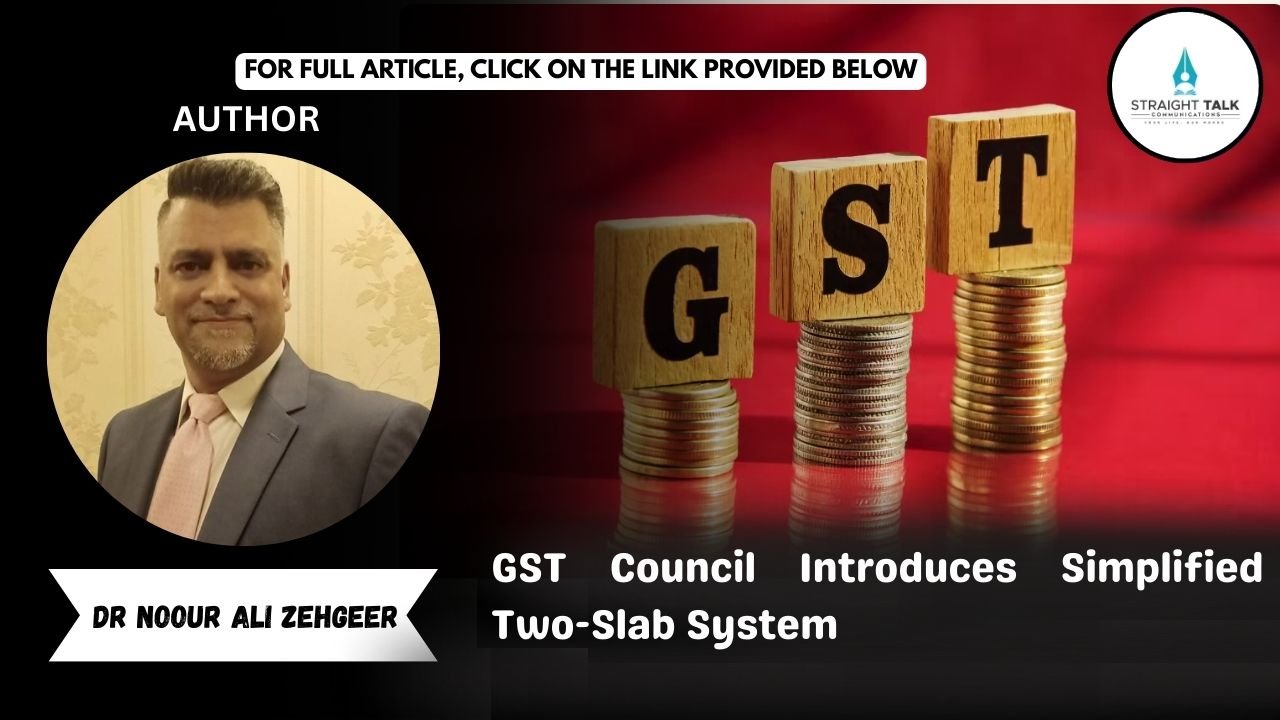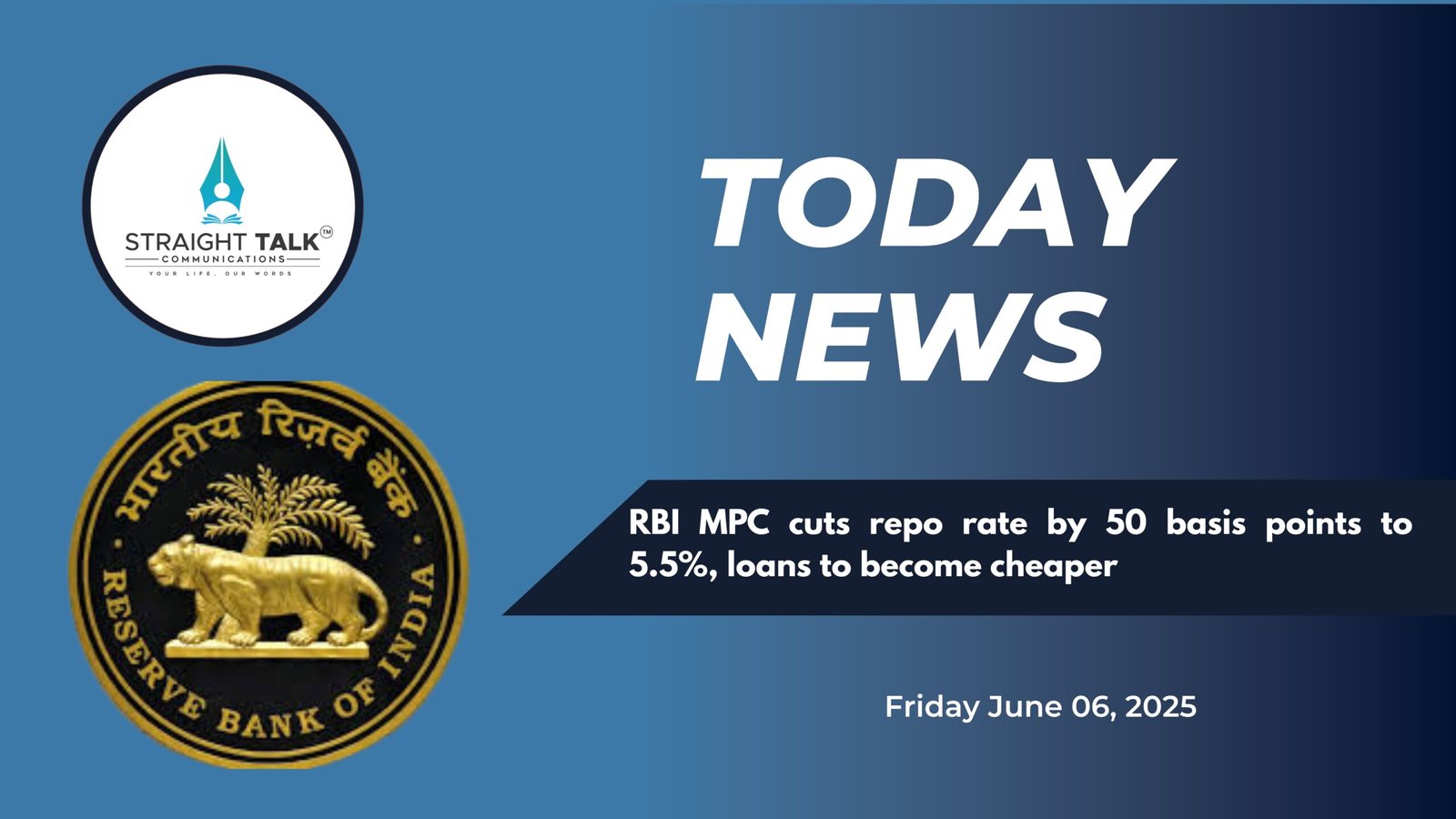GST Reform: A Big Relief for Consumers

GST Council Introduces Simplified Two-Slab System
Dr Noour Ali Zehgeer
Once again NDA government have decided to take U Turn on their own decisions. When Mandir Politics cannot help in Bihar elections and Falling economy, this was the last correction they could have thought of after many historic economic blunders. I still remember what MMS(ex-Prime Minister of India) said when BJP was bragging about GST in Public and Parliament. He was suggesting the same thing including the present LOP Rahul Gandhi, never late than too late.
In a historic decision that will touch every household and business in India, the Goods and Services Tax (GST) Council has approved a major simplification of the country’s indirect tax system. After years of debate, the existing four-tier structure of 5, 12, 18, and 28 per cent has been scrapped. In its place, a two-rate regime of 5 per cent and 18 per cent will now apply, along with a special 40 per cent slab for luxury and sin goods.
The landmark decision came after a marathon 10.5-hour session of the GST Council, its 56th meeting since the system’s inception in 2017. Finance Minister Nirmala Sitharaman announced that the revised structure will come into effect on September 22, coinciding with the start of the festive season of Navaratri.
She also noted that the reform received unanimous support from all states, a rare moment of consensus in India’s often divided political landscape. “The simplified tax structure is aimed at easing compliance, reducing costs, and giving direct relief to citizens,” she said. Prime Minister Narendra Modi hailed the move as a “festival gift” that will improve the lives of farmers, small traders, middle-class families, and micro, small, and medium enterprises (MSMEs), while also boosting economic activity.
Essentials Become Cheaper
The biggest winners of the new tax regime are ordinary consumers, as many essential goods and services are set to become more affordable.
Insurance Relief: Individual life and health insurance policies, which previously attracted 18 per cent GST, will now be completely exempt. This is expected to encourage more families to invest in financial and health security.
Food Products: A host of everyday food items such as paneer, roti, paratha, pizza bread, khakra, and chena will now be free of GST. Dairy items like butter, ghee, cheese, and condensed milk, along with dry fruits, jams, jellies, ice creams, pastries, biscuits, cornflakes, and other cereals, have been reduced to a 5 per cent slab from the earlier 12–18 per cent.
Agriculture Boost: Inputs like sulphuric acid, nitric acid, ammonia, and biopesticides, crucial for farming, will now be taxed at 5 per cent. Agricultural machinery including tractors, threshers, and soil-preparation tools too falls in the same slab. This will directly cut costs for farmers.
Transport Relief: Small petrol cars (below 1200cc), diesel cars (below 1500cc), and motorcycles up to 350cc, earlier taxed at 28 per cent, will now attract only 18 per cent GST. Hybrid vehicles also benefit from this cut. Electric vehicles remain at a low 5 per cent, in line with the government’s push for sustainable transport.
Everyday Goods: Items like shampoo, toothpaste, toothbrushes, soaps, talcum powder, hair oil, feeding bottles, utensils, bicycles, umbrellas, and bamboo furniture are all down to 5 per cent GST.
Infrastructure Materials: Cement, which was among the costliest items under GST at 28 per cent, has been brought down to 18 per cent. Auto components too have been shifted to the 18 per cent slab, reducing the cost of repairs and spare parts.
These changes are expected to directly bring down household expenses while giving a boost to consumption, especially in the upcoming festive season.
What Gets Costlier
While essential goods have become cheaper, the government has tightened taxation on products deemed harmful or luxurious by moving them to the 40 per cent slab.
Sugary Beverages: Aerated drinks, soft drinks, colas, fruit-based carbonated beverages, and energy drinks will now face 40 per cent GST, up from 28 per cent.
Luxury Vehicles: Cars with large engines (petrol above 1200cc or diesel above 1500cc) and longer than 4,000 mm, as well as motorcycles above 350cc, racing cars, yachts, and personal aircraft, will now be taxed at 40 per cent.
Flavoured Beverages: Drinks containing added sugar or artificial sweeteners will also face the highest tax rate.
Tobacco and Related Products: Pan masala, gutkha, cigarettes, chewing tobacco, and bidi will remain at 28 per cent plus compensation cess for now, but will eventually migrate to the 40 per cent category once cess dues are cleared.
The message is clear—necessities will get cheaper, but luxury and harmful products will be discouraged through higher taxation.
Why the Reform Matters
The GST regime, introduced in 2017, was hailed as India’s biggest tax reform since independence. However, its multiple slabs created confusion, litigation, and compliance hurdles for businesses. Disputes often arose over which slab a product should fall into, leading to costly delays and frustration for both consumers and companies.
The new system addresses these concerns:
1. Simplified Compliance: With fewer slabs, filing returns will become easier, reducing classification disputes.
2. Consumer Relief: The tax burden on essentials is reduced, putting more money back in people’s hands.
3. Economic Growth: Lower taxes on cement, fertilizers, and auto components are expected to spur growth in agriculture, infrastructure, and manufacturing.
4. Health and Lifestyle Shift: Heavier taxation on sugary drinks and tobacco products aligns with public health goals.
5. Green Push: Continued lower GST on electric vehicles reflects India’s commitment to cleaner energy and transport.
Festive Timing
The government’s decision to roll out the new rates on September 22, just as Navaratri begins, is also strategic. The festive season traditionally sees a surge in consumer demand for food items, personal care products, and vehicles. By cutting taxes on essentials and small vehicles, the government is hoping to trigger a wave of spending that could further boost economic recovery.
Conclusion
The GST Council’s move to simplify the tax structure marks a turning point in India’s economic policy. By reducing the number of slabs, making essentials cheaper, and targeting luxury and harmful consumption with higher rates, the reform balances relief with responsibility.
For households, this means lower bills on daily essentials. For farmers, cheaper inputs and machinery. For small traders and MSMEs, reduced compliance headaches. And for the economy at large, a stronger push towards growth and sustainability.
As India steps into the festive season, this bold reform may well prove to be the most meaningful gift the government could deliver—a simpler tax system, lighter on essentials, heavier on luxuries, and better aligned with the nation’s needs.







